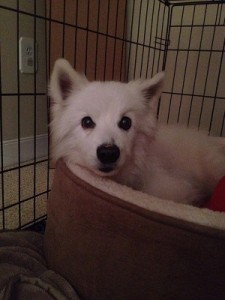Pet Health
12/31/2018
Signs of a Healthy Dog – The Picture of Health
Probably more than anything, our responsibility as a dog owner is to make sure our dog is healthy and happy.…
Monday – Friday
7:00 am – 7:00 pm
Saturday
7:00 am – 6:00 pm
Sunday
9:00 am – 6:00 pm
Monday – Friday
7:00 am – 7:00 pm
Saturday
7:00 am – 6:00 pm
Sunday
9:00 am – 6:00 pm

Author: Melanie Benware, Holiday Barn Dog Trainer
As a Dog Trainer, I often receive calls from exhausted owners inquiring about what they can do to help their puppy or recently adopted dog become a more mannerly member of the family. One or a combination of the following dog training tips can help with many of the behaviors people are struggling with.

Crate Training is critical when you bring a new dog or puppy into the house. Crate training helps with so many issues, from potty training to setting boundaries. Having a crate can prevent bad habits from forming and it can reduce stress for your new family member. Your dog should be in her crate any time you cannot supervise her, including short periods of time while you are home; thereby preventing possible destructive or unwanted behaviors. Feeding your dog while in her crate will help her to associate it with something very favorable. In order for crate training to be successful you need to be consistent. It is essential that your dog understands that the crate is a positive environment and not a form of punishment. If you notice your dog becomes anxious when put in the crate, try covering the crate with a blanket (to make it dark and encourage sleeping), leaving a TV or radio on, or giving your dog a special bone (elk antler, femur bone, etc.) to distract her while in the crate.

Structured feeding times will help you with potty training, reduce the start of behavioral problems, and is a very subtle way for you to assert yourself as the leader. I recommend that you put food down for your dog in the morning. If after 15 minutes, your dog hasn’t eaten all of her food, take it back up and do not give it back to your dog until the next time you decide she can eat (usually at dinner time). Do the same thing at dinner. Do not add the dinner amount to the left over breakfast and vice versa. Only offer the amount they should eat at that time; you do not want to encourage them to gorge on food. This is the part that some owners struggle with in the beginning. It is normal for a dog to not eat much for a couple days during the change from free-feeding to structured feeding times.
Have your dog earn the right to be on the furniture. Keeping your dog off your furniture sets boundaries and can be accomplished with not only a new dog, but one you already have. Sharing the sofa or bed is a privilege your dog should earn. This is a tough one but stay strong. This doesn’t have to be forever but at least until your dog has learned to follow your lead in and out of the house, is completely potty trained, and does not display unwanted behaviors.

You should not leave your dog loose or unattended until he is fully potty trained, has respect for your house and yard, and has a firm grasp on training. Supervision is key. This goes back to step number one, crate training. If you are unable to supervise your dog, he should be in his crate.
Exercise is imperative for all dogs, some requiring more than others. Understanding your dog’s needs and meeting them is vital to your dog’s behavior. Try to take at least one 30 minute walk per day. Dogs need structured exercise as well as playtimes. Just allowing them to run around the back yard is not enough. Taking your dog for a walk will help burn off physical and mental energy and when done properly it helps you demonstrate your leadership and strengthen the bond you share.
Setting limits and rules is important and so is sticking with them. Being inconsistent can lead to confusion for your dog and frustration for your family. Dogs thrive on structure and your relationship will benefit from it. It is extremely important that ALL family members of the house follow the rules. It is not fair for one person to correct your dog for a certain behavior but another person lets her get away with it. You dog will drastically improve on her training if you all stay consistent and apply the same rules.
Remember to take things slow and do not overwhelm your dog. When you first start out in training or make changes to your dog’s rules, it is important that you do not push too fast. Dog training is all about timing and consistency so that you can build your dog up for success. When trying something new try to end on a positive note. If you teach something new and your dog struggles, take a step back to a command they do know and end there. If you stay consistent with correcting unwanted behaviors, praise and reward for good behavior and supervision your dog will succeed quickly.
The most important part of dog training and having your dog be a successful member of the family is to continue training. It is a wonderful way to strengthen the relationship with your dog. Do not give up; dogs love learning and there is no limit to the things you can teach your dog! In the time you spend together your dog just might teach you something too!
Pet Health
12/31/2018
Probably more than anything, our responsibility as a dog owner is to make sure our dog is healthy and happy.…